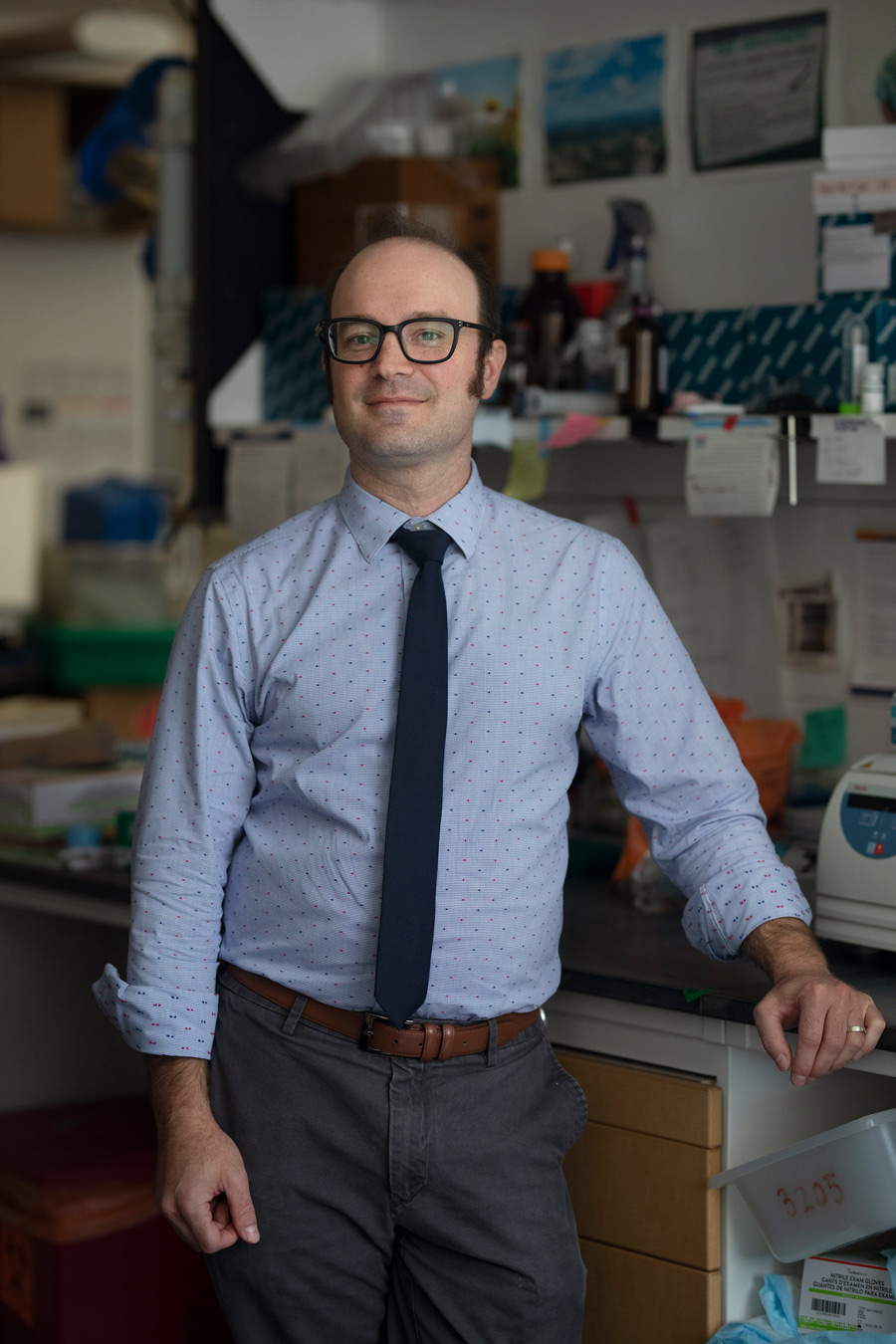on’t let the Clark Kent glasses fool you: When Timothy Sheahan ’99 goes into saving-the-world mode, he doesn’t duck into a phone booth and emerge in a cape and tights. Instead, he dons a full Tyvek suit, two pairs of gloves, booties and an enclosed hood connected to a battery-powered respirator that delivers sterile breathing air — and locks himself into a room with a biosafety cabinet. That’s because, since the beginning of the year, Sheahan has been directly engaging with something that virtually the entire world has turned itself upside down to avoid: SARS-CoV-2, the virus that causes COVID-19. A virologist in the Baric Lab at the University of North Carolina-Chapel Hill’s Gillings School of Global Public Health, Sheahan is an expert on coronaviruses, and one of a handful of research scientists on the frontlines of the efforts to find a treatment that might halt the global pandemic.
“There’s definitely a lot of pressure,” Sheahan says of his work evaluating new drugs and potential vaccines for COVID-19. “We’re working at warp speed and the stakes are incredibly high. Being involved in this effort has been the best thing ever and the worst thing ever at the same time.”

The 43-year-old Sheahan didn’t set out to be a virology superhero — or even a microbiologist, for that matter. The Rhode Island native chose UNH for its natural resources department and water resources management (WRM) major, a prerequisite for which was an introductory course in microbiology. “It was eye-opening,” he recalls of the course he took his sophomore year, laughing as he confesses to avoiding some of the “harder-core” science courses as a freshman out of concern that he might not be cut out for the academic rigor. Not only did microbiology provide a view into a very-real-if-microscopic world that exists all around us all the time, Sheahan says, “It made me realize the power of microbes and their ability to make you sick or even kill you, and they’re these tiny little things.”
It’s not every student who would find enchantment in the discovery of lethal microbes, but Sheahan was all in. He added a microbiology major to his WRM studies, and after graduating late to complete it, quickly landed at Harvard Medical School, where a UNH cell culture class helped him secure a job making viral vectors for gene therapies — that is, using viruses for good, as a way to deliver beneficial genetic material into the chromosomes of human cells. After a few years at Harvard, he moved to Massachusetts General Hospital and the Mass Eye and Ear Infirmary to work on tissue engineering, and then headed south to UNC for a doctorate in microbiology and ultimately a faculty position in the Baric Lab, one of the country’s leading centers for coronavirus research. Sheahan was studying a different coronavirus — Middle East Respiratory Syndrome, or MERS — and the efficacy of the antiviral drug remdesivir to combat it, when COVID-19 appeared.
The virus first hit Sheahan’s radar on New Year’s Day, as he was texting with friends about a new outbreak of viral pneumonia documented by ProMED, an international global reporting system for infectious diseases. “I try to avoid all things related to work over the holidays, but this caught my attention,” Sheahan recalls. By January 10, the outbreak was confirmed to be a coronavirus — so called for the crownlike spikes on its surface — and when cases began cropping up in Germany and Italy, “I knew it couldn’t be stopped from spreading all over the world.”
Like many other coronaviruses, SARS-CoV-2 has existed for years in animal populations; it jumped to humans as a result of molecular adaptations that allowed it to infect human cells, as well — a phenomenon known as emergence. SARS-CoV-2 is the third human coronavirus to emerge in the past 20 years, and Sheahan says it won’t be the last. That, he explains, is among the reasons it’s so critical to explore as many treatment options as possible. “Not just to get this pandemic under control, but to understand these viruses and their mechanisms better so we’re more prepared when the next thing comes along.”
The urgency and global relevance of Sheahan’s work have made him something of a celebrity. In April he was the subject of a GQ magazine feature, after which his Twitter following burgeoned from 500 to more than 25,000. “It’s super weird,” he says. The upside is that his young children — in first and third grades — now have some sense of the work he does, if not necessarily how cool that makes him.
Indeed, Sheahan is much quicker to express awe at their grasp of the science of his work than he is to reflect on his own importance. “They have an understanding of microbiology and virology that I never, ever thought they would get, and that’s really amazing,” he says. “They think I work a lot, but they don’t really have a sense of how that relates to the way the world has changed around them this past year.”
Like any good superhero, he keeps that part under wraps.